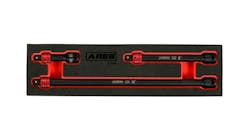A long time local tech here in Miami named Mario Aristides (and quite the personality as well), has made a living working on and repairing automatic transmissions in European vehicles. He recently worked on a ZF6HP transmission in a 2005 BMW 745Li vehicle (Figures 1 and 2). He had made some modifications to the valve body and he and a fellow tech went out for a test ride.
The transmission was shifting well, but they noticed the vehicle was low on fuel and decided to stop to get some gas. After fueling up, they started the vehicle and went to drive off, but the transmission felt like it was bound up both forward and reverse. Having just finished working on the transmission, he immediately thought something he did went wrong. His first thought was to pull the emergency Park release cable as this transmission engages and disengages park electronically. The handle for this is located under the dash behind a small door that can be accessed using the ignition key. Once the lever becomes accessible, pulling on it mechanically releases the transmission from a park engagement via a Bowden cable.
FIGURES 1-3Once he pulled on this lever, the transmission still felt bound up in forward and reverse. He had no other choice but to call for a tow to bring the vehicle back to the shop. When the driver of the tow truck arrived, having experiences with this issue before with other BMW 7 series vehicles, he knew about both the emergency park release cable and the emergency parking brake system.
There is a very sophisticated traction control system utilizing a Dynamic Stability Control (DSC) strategy. Part of this braking system includes an Electro-mechanical Actuating Unit (EMF). When the EMF receives a request to activate the parking brake, it operates an electric actuator (motor) to tension the parking brake cables. This unit is located under the luggage compartment floor in front of the spare wheel recess (Figures 3 and 4).
FIGURES 4-6When malfunctions occur, all four wheels can have their brakes applied, preventing the vehicle from moving. Normal safety reasons incorporated into the computer strategy that will cause an Automatic Hold would be if the hood contact switch indicated an open hood. Another would be that the driver stepped out of the vehicle while the engine is running noted by seat occupant sensor. Once the driver returns sitting down into the seat stepping on the brake to select drive or reverse, the EMF system will deactivate the automatic hold feature.
Mario never considered looking at the instrument cluster when he felt what he thought was a bind up thinking he did something wrong to the transmission. What actually was happening was that something was wrong with the ABS system, which illuminated the ABS light. The bind up Mario thought he felt was a transmission in gear trying to move a car with all the brakes applied (The gears in the EMF system are known to strip out causing a no brake release issue simulating a similar condition).
FIGURES 7-8The tow driver saw the ABS light on and knew what was occurring. He also knew of an emergency release procedure of the brake system. In the trunk there is a tool kit with a special tool (Figures 5 through 8) to be used to release the brake hold through the mechanical actuating parking brake unit. Once the driver released the brakes using this tool, Mario was relieved knowing that what he thought was a bind was a brake problem and he drove himself back to the shop.
Subscribe to Motor Age and receive articles like this every month…absolutely free. Click here
.jpg?auto=format,compress&fit=max&q=45&w=250&width=250)
.jpg?auto=format,compress&fit=max&q=45&w=250&width=250)
.JPG?auto=format,compress&fit=max&q=45&w=250&width=250)
.JPG?auto=format,compress&fit=max&q=45&w=250&width=250)
.jpg?auto=format,compress&fit=max&q=45&w=250&width=250)
.jpg?auto=format,compress&fit=max&q=45&w=250&width=250)
.JPG?auto=format,compress&fit=max&q=45&w=250&width=250)
.JPG?auto=format,compress&fit=max&q=45&w=250&width=250)

